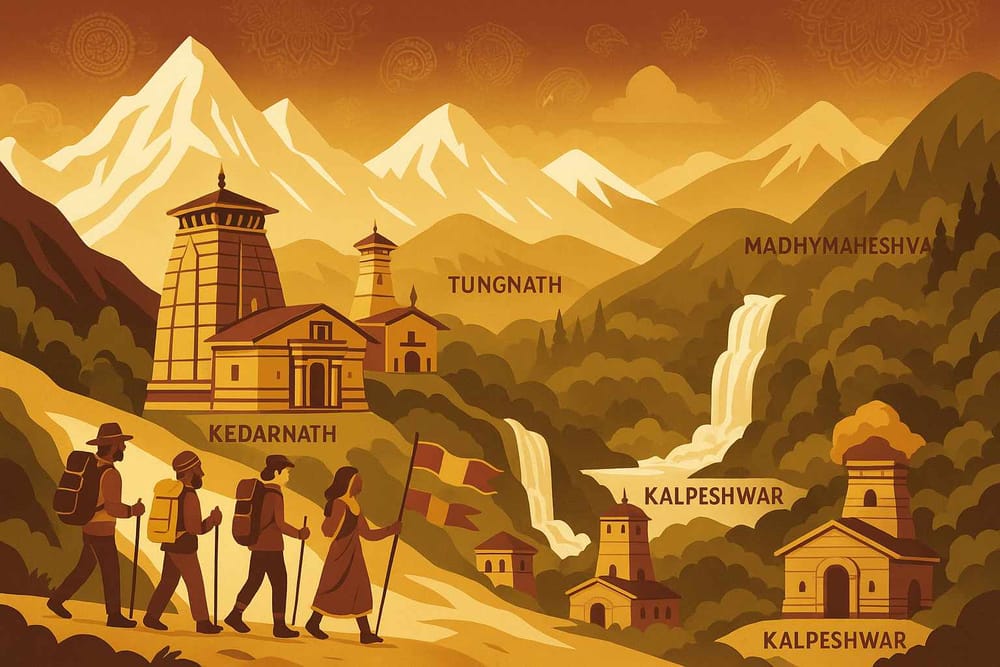
India's Sacred Geography: A Panch Kedar Pilgrimage Guide
Embarking on the Panch Kedar Yatra is a deeply spiritual journey into the Garhwal Himalayas of Uttarakhand. This sacred circuit of five temples—Kedarnath, Tungnath, Rudranath, Madhyamaheshwar, and Kalpeshwar—honors Lord Shiva in his various forms. Rooted in mythology, this pilgrimage offers an enriching blend of devotion, breathtaking landscapes, and a connection to India's timeless traditions.
The Legend and Significance of the Panch Kedar Yatra
The Panch Kedar temples hold immense significance, rooted in the epic Mahabharata. Legend says that the Pandavas sought Lord Shiva's forgiveness after the Kurukshetra war. To avoid them, Shiva took the form of a bull and submerged into the earth, his body parts appearing in different locations. These locations became the revered Panch Kedar temples:
- Kedarnath: Represents Shiva's hump, a symbol of strength and resilience. Pilgrims feel a deep connection to the divine presence of Shiva here.
- Tungnath: Symbolizes his arms, representing power and protection. The serene atmosphere of this temple offers a space for quiet reflection and prayer.
- Rudranath: Depicts his face, radiating grace and compassion. The captivating natural beauty surrounding the temple enhances the spiritual experience.
- Madhyamaheshwar: Signifies his navel, the center of creation and sustenance. Pilgrims experience a sense of renewal and connection to the divine energy.
- Kalpeshwar: Represents his hair, a symbol of wisdom and asceticism. This temple, open year-round, offers a sanctuary for spiritual seekers throughout the seasons.
Visiting these temples is not just an act of devotion; it's a transformative spiritual ascent. The journey fosters harmony between nature and spirituality, as the temples are nestled amidst unspoiled Himalayan beauty. These shrines also safeguard ancient Shaivite traditions and rituals, representing India’s rich cultural heritage.
About Us: Your Path to Bhakti & Beyond
Bhaktilipi.in is your sacred digital haven, lovingly preserving and sharing India's rich tapestry of devotional literature and stories. We reimagine these timeless treasures to connect with today's seekers, inspiring hearts and nurturing spiritual growth. Explore Bhaktilipi.in and embark on your personal journey of devotion and discovery.
Why Subscribe to Bhaktilipi?
Delve into insightful articles like *Exploring India's Sacred Geography: A Journey to Panch Kedar Temples*, unveiling the rich history, significance, and rituals of India's spiritual landmarks. With easy-to-understand content, we illuminate the path to deeper understanding. Subscribe to our newsletter, join our YouTube channel, or follow us on social media to stay connected with authentic content that nourishes your soul.
Connect With Us:
- Facebook: Bhaktilipi Official
- Instagram: @bhakti_lipi
- YouTube: Bhaktilipi Channel
Join us today and let the wisdom of Bhakti flow into your life!
Embracing the Sacred Journey
The Panch Kedar pilgrimage is more than a trek; it's a spiritual awakening amidst the Himalayas, connecting you with India's rich traditions and sacred landscapes. Each temple, nestled in these majestic mountains, whispers tales of devotion and Lord Shiva’s divine presence.
Planning your pilgrimage is easier now with Bhaktilipi.in . Discover authentic puja items and expert guidance to prepare for this transformative journey.
Let the Panch Kedar pilgrimage be your inspiration. It's a journey that reminds us that the path to the divine is as sacred as the destination.
FAQs on India's Sacred Geography: A Panch Kedar Pilgrimage Guide
What is the legend behind the Panch Kedar Yatra?
The Panch Kedar Yatra finds its roots in the Mahabharata. It is believed that the Pandavas sought Lord Shiva’s blessings at these five temples to atone for their actions during the Kurukshetra war. Lord Shiva, in the form of a bull, dispersed parts of his divine form across these locations, establishing them as the sacred Panch Kedar sites.
Why is the Panch Kedar pilgrimage considered significant?
The Panch Kedar pilgrimage isn't just a spiritual journey; it's a celebration of nature's majesty and a deep connection with Lord Shiva. Amidst the serene Himalayan landscapes, each temple holds a unique significance, representing a different aspect of Shiva's divine presence.
What are the five temples in the Panch Kedar circuit?
The five revered temples are Kedarnath, Tungnath, Rudranath, Madhyamaheshwar, and Kalpeshwar. Each temple embodies a specific part of Lord Shiva's divine form. They are not just structures but living embodiments of devotion and spiritual energy.
What is the best time to undertake the Panch Kedar Yatra?
The ideal time for this sacred journey is from May to October. The weather is generally favorable, and all the temples are open. It's best to avoid the monsoon season due to potential travel difficulties.
What are some tips for preparing physically for the Panch Kedar trek?
Preparing for the Panch Kedar trek involves building stamina and strengthening your legs. Regular walks, yoga, and light cardio can help. Be sure to have proper trekking gear, comfortable shoes, and stay hydrated.
How can one prepare spiritually for the Panch Kedar pilgrimage?
Spiritual preparation includes meditation, chanting mantras dedicated to Lord Shiva, and learning about the significance of each temple. A peaceful mind and a heart full of gratitude will enrich your pilgrimage immensely.
Are there any rituals to follow during the Panch Kedar Yatra?
Devotees typically perform abhishekam (a ritual bath) and offer prayers at each temple. Respecting the customs and traditions of each temple is essential. Many devotees also choose to fast as part of their spiritual practice.
Can the Panch Kedar Yatra be completed in a single trip?
Yes, the Panch Kedar Yatra can be done in one trip, but careful planning is essential. Each trek varies in difficulty, and the journey can take around 15-20 days. Consider your fitness level and plan accordingly.
A passionate group of people dedicated to preserving India's knowledge of Dharma, Karma, and Bhakti for ourselves and the world 🙏.
